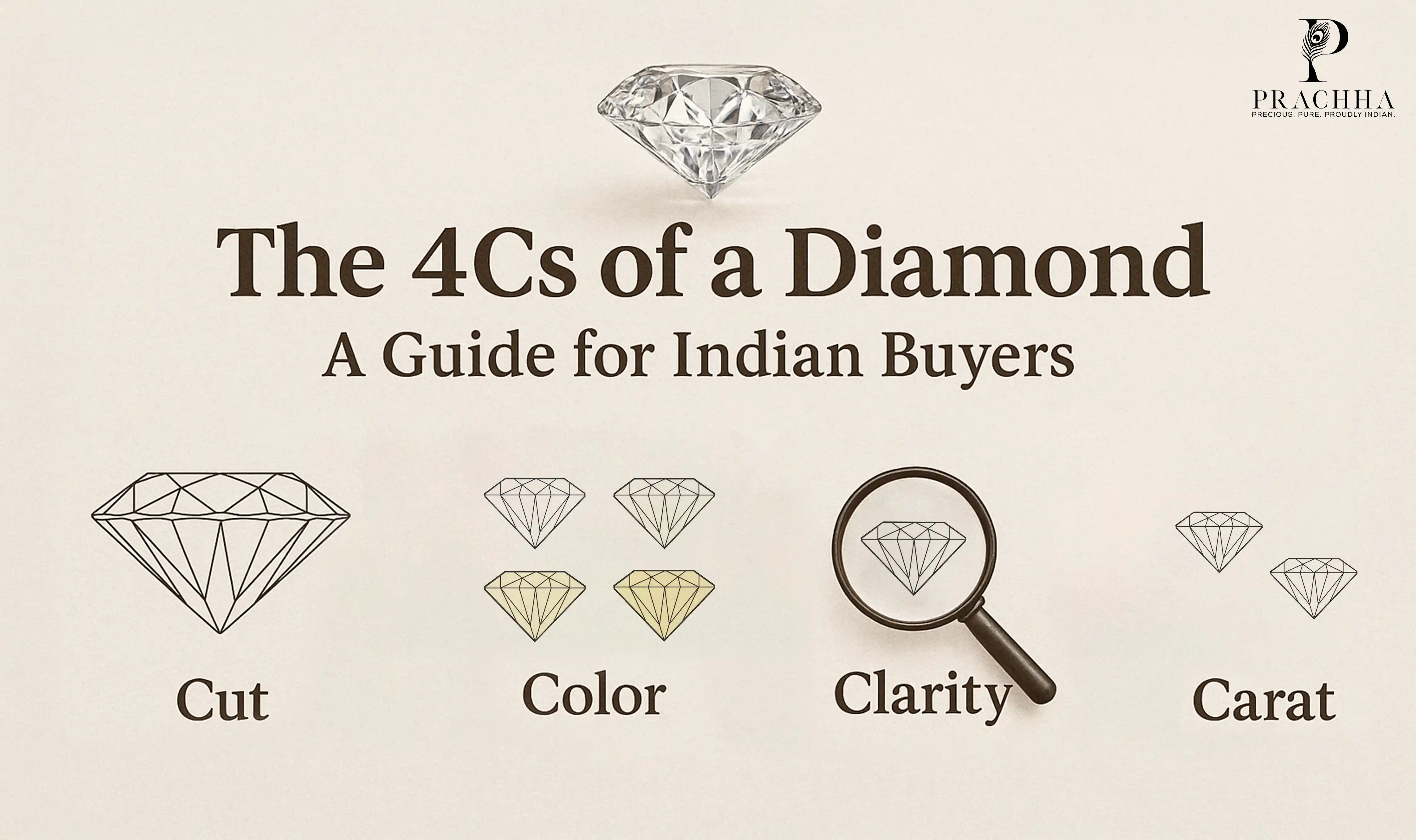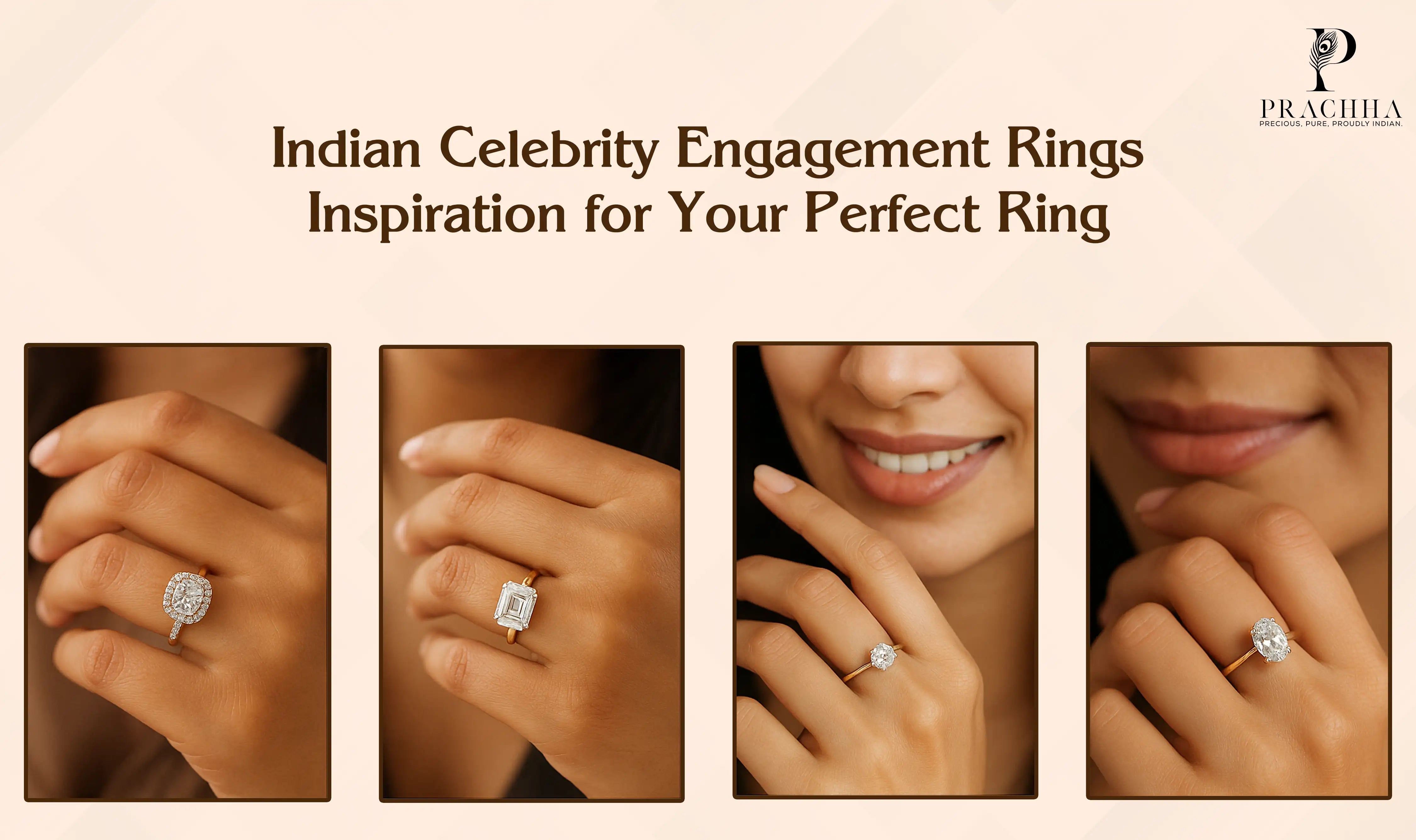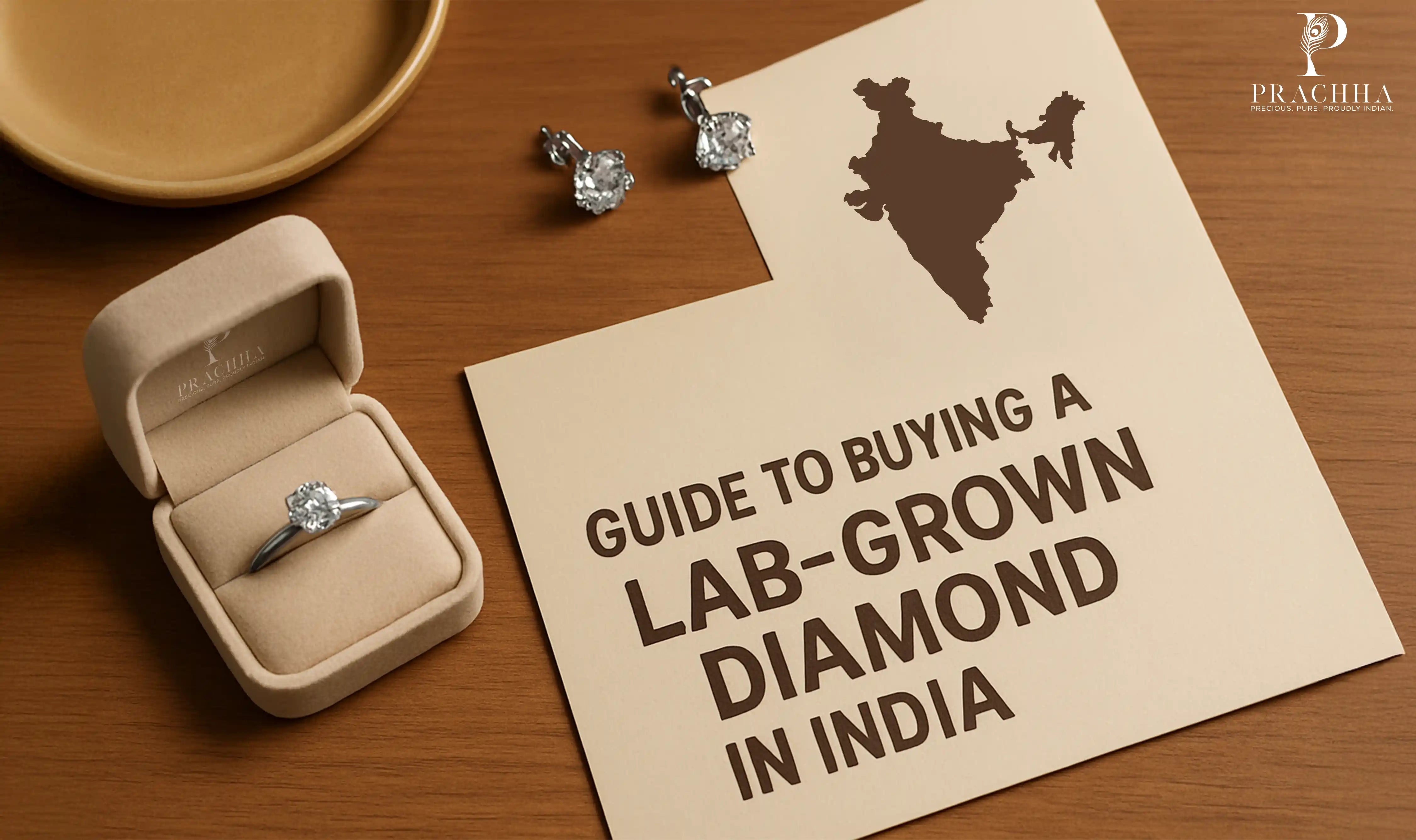
The 4Cs of a Diamond- A Guide for Indian Buyers
Diamonds, whether lab-grown or natural, are cherished for their brilliance and timeless appeal in India, where jewelry holds deep cultural significance. Understanding the 4CsCut, Color, Clarity, and Caratis essential for choosing the perfect diamond, especially in the booming lab-grown diamond market, valued at $2.61 billion in 2023 and projected to reach $8.31 billion by 2032. This guide explains the 4Cs in detail, helping Indian buyers make informed decisions when purchasing lab-grown diamond jewelry in cities like Mumbai, Delhi, or Surat.
What Are the 4Cs?
The 4Cs are the universal standards used to evaluate a diamond’s quality, developed by the Gemological Institute of America (GIA) and widely adopted by labs like the International Gemological Institute (IGI), popular in India. These criteria Cut, Color, Clarity, and Carat determine a diamond’s appearance, value, and suitability for jewelry, whether for an engagement ring, mangalsutra, or earrings.
1. Cut: The Key to a Diamond’s Sparkle

The cut of a diamond refers to how well it has been shaped and polished to maximize its brilliance, fire (color dispersion), and scintillation (sparkle). It’s the most critical of the 4Cs because it directly affects how the diamond reflects light, a quality Indian buyers prize for its visual impact.
- How It’s Graded: Cut is graded from Excellent (Ideal) to Poor, based on proportions, symmetry, and polish. An Excellent cut reflects nearly all light entering the diamond, creating maximum sparkle.
- Popular Cuts in India:
-
- Round Brilliant: The most popular for its unmatched brilliance, often pricier due to high demand in Indian engagement rings.
- Princess: Square-shaped with sharp corners, offering a modern look.
- Oval and Cushion: Elongated shapes that appear larger per carat, ideal for earrings and pendants.
- Lab-Grown Advantage: Lab-grown diamonds often achieve Excellent cuts due to precise manufacturing, ensuring stunning sparkle at a lower cost (e.g., a 1-carat round brilliant lab-grown diamond costs ₹28,000–₹90,000).
Tip for Indian Buyers: Prioritize an Excellent or Very Good cut for maximum brilliance, especially for visible jewelry like solitaire rings. Check the cut grade on IGI or GIA certificates.
2. Color: The Hue of Elegance

Color measures the presence of tint in a diamond, with less color indicating higher quality. In India, colorless or near-colorless diamonds are preferred for their versatility in gold settings, from traditional 22K to modern 18K BIS-hallmarked designs.
- How It’s Graded: Color is graded from D (colorless) to Z (light yellow or brown).
-
- D–F: Colorless, offering the brightest sparkle, ideal for high-end jewelry.
- G–J: Near-colorless, excellent value for Indian buyers as slight tints are often undetectable in gold settings.
- K–Z: Noticeable yellow tints, less common in fine jewelry.
- Lab-Grown Advantage: Lab-grown diamonds frequently achieve D–F grades due to controlled production, making colorless stones more accessible. For example, a 1-carat D-color lab-grown diamond may cost ₹50,000–₹1,00,000, compared to ₹2,00,000+ for a natural one.
Tip for Indian Buyers: Choose D–F for colorless brilliance or G–I for value, especially in smaller diamonds where color differences are less noticeable. Verify the color grade on the certificate.
3. Clarity: The Mark of Purity

Clarity assesses a diamond’s internal and external flaws, known as inclusions and blemishes. In India, where diamonds symbolize purity, high-clarity stones are sought after, though minor flaws are often invisible to the naked eye.
- How It’s Graded: Clarity ranges from Flawless (no inclusions or blemishes under 10x magnification) to Included (I1–I3, visible flaws).
-
- FL/IF (Flawless/Internally Flawless): Rare and expensive.
- VVS1–VVS2 (Very, Very Slightly Included): Minor inclusions, invisible without magnification, popular for premium lab-grown diamonds.
- VS1–VS2 (Very Slightly Included): Excellent value, with tiny inclusions not visible to the naked eye.
- SI1–SI2 (Slightly Included): Affordable, with flaws sometimes visible under close inspection.
- Lab-Grown Advantage: Lab-grown diamonds often achieve VVS1 or VS1 clarity due to precise manufacturing, offering near-flawless quality at lower prices (e.g., a 1-carat VVS1 lab-grown diamond costs around ₹60,000–₹90,000).
Tip for Indian Buyers: Opt for VVS1–VS2 clarity for high-quality lab-grown diamonds that look flawless without magnification. SI1 can be a budget-friendly choice for smaller stones or less visible settings like earrings.
4. Carat: The Measure of Size

Carat refers to a diamond’s weight, with 1 carat equaling 200 milligrams. In India, carat size is a key consideration for statement pieces like engagement rings or mangalsutras, but larger sizes come at a higher cost.
- How It’s Measured: Carat weight affects a diamond’s size and price. For example:
-
- A 0.25-carat lab-grown diamond costs around ₹20,000, ideal for stud earrings.
- A 1-carat lab-grown diamond ranges from ₹28,000–₹1,00,000, perfect for solitaire rings.
- A 2-carat lab-grown diamond may cost ₹1,50,000–₹2,50,000, offering a bold statement.
- Lab-Grown Advantage: Lab-grown diamonds allow Indian buyers to afford larger carat sizes. For instance, a 2-carat lab-grown diamond is 60–70% cheaper than a natural one, making larger stones accessible for budget-conscious buyers.
Tip for Indian Buyers: Balance carat with cut and color for the best appearance. A well-cut 1-carat diamond often looks more impressive than a poorly cut 1.5-carat one. Consider shapes like oval or cushion, which appear larger per carat.
Why the 4Cs Matter for Lab-Grown Diamonds in India
Lab-grown diamonds, produced in hubs like Surat, offer Indian consumers unmatched value. Their Pragmatic Play’s web and X posts note that lab-grown diamonds are up to 90% cheaper than natural diamonds, allowing buyers to prioritize higher-quality 4Cs (e.g., Excellent cut, D color, VVS1 clarity) without breaking the bank. The 4Cs ensure you get the best value by helping you compare diamonds systematically.
- Affordability: A 1-carat lab-grown diamond with excellent 4Cs costs ₹28,000–₹1,00,000, compared to ₹2,00,000+ for a natural diamond.
- Quality: Controlled production ensures high clarity and color grades, with many lab-grown diamonds being Type IIa (purest form).
- Certification: IGI and GIA certifications, widely trusted in India, confirm the 4Cs, ensuring authenticity.
Tips for Applying the 4Cs in India

- Prioritize Cut: An Excellent cut maximizes sparkle, crucial for visible pieces like engagement rings, popular in India.
- Balance Color and Clarity: Choose D–F color and VVS1–VS2 clarity for premium look, or G–I and SI1 for budget-friendly options.
- Consider Carat Wisely: Larger carat sizes are more affordable with lab-grown diamonds, but ensure the cut enhances perceived size.
- Check Certification: Always verify IGI or GIA certification to confirm the 4Cs. Look for a laser inscription on the diamond’s girdle.
- Shop Smart: Compare retailers in urban centers like Mumbai, Delhi, or online platforms for transparent pricing and IGI-certified diamonds.
- Choose Sustainable Options: Look for retailers using renewable energy for eco-friendly lab-grown diamonds, aligning with India’s growing focus on sustainability.
Where to Buy Lab-Grown Diamonds in India
- Physical Stores: Visit reputable jewelers in cities like Mumbai, Delhi, or Chennai for hands-on viewing and expert guidance.
- Online Platforms: Shop on websites offering detailed 4C filters, high-resolution images, and secure transactions. Ensure a 7-day return policy.
- Reputable Retailers: Choose retailers offering IGI or GIA-certified diamonds, transparent pricing, and strong after-sales policies like 80–100% buyback or lifetime exchanges.
Tip: Check customer reviews and sustainability credentials to ensure ethical and high-quality purchases.
Making the Right Choice
The 4Cs empower Indian buyers to select lab-grown diamonds that match their style, budget, and values. With lab-grown diamonds offering up to 70% savings, you can invest in higher-quality cuts, colors, or larger carats without compromising ethics or sustainability. Whether you’re buying a sparkling solitaire for a proposal or a mangalsutra for a special occasion, understanding the 4Cs ensures you get the best value in India’s thriving lab-grown diamond market.
Ready to shine? Use the 4Cs to find a lab-grown diamond that reflects your style and conscience, and explore trusted retailers to make your purchase with confidence.


















